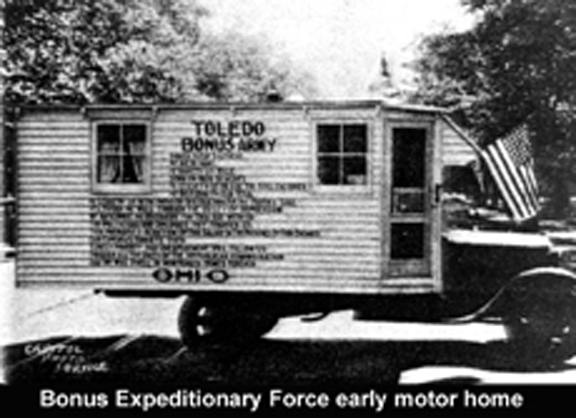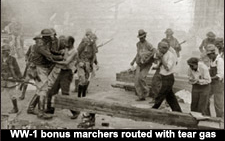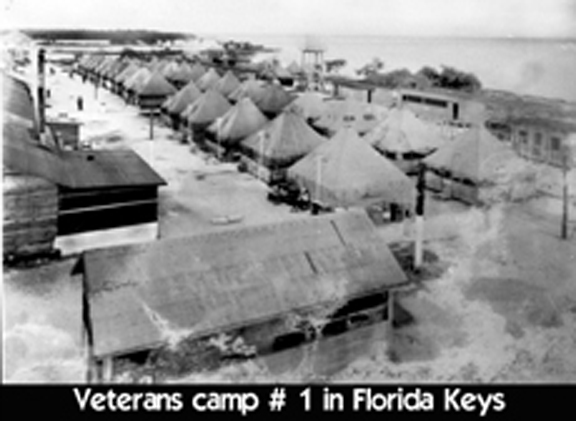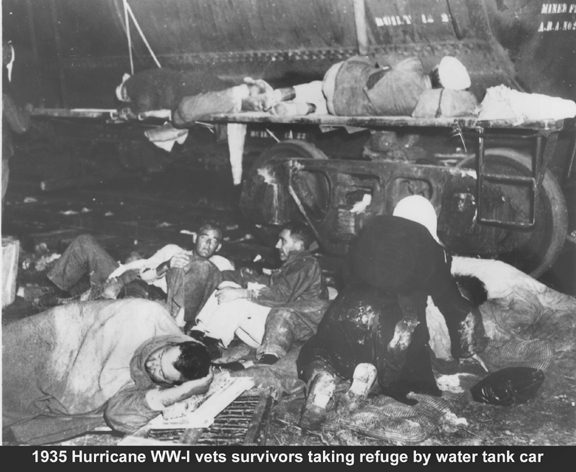|
- HISTORY OF THE UPPER KEYS -
- The Four WW-1 Veteran Photos - - An introduction - - By Jerry Wilkinson - Compilation
date = July 7, 2010
I titled this four WW-1 Veteran Photos, but I will show seven photos.
When
designing the web homepage my thought was to depict the chronological
history of the WW-1 vets' plight to have their approved 1945 bonus paid
early - I had the seven photos, but could not arrange them as I wanted
- so here
they
are now. The time period is from some time in early 1932 to late 1935.
The chronology is important and Paul Dixon tells the story very well in his book - The Bonus Army, An American Epic. Google Bonus Army and there are many great sites of this first stage of struggle. A very short version is below. The war was over in 1918, and each serviceman received $60 mustering out pay. In total there were about four million veterans, some veterans also of the Spanish American War - they received no form of a bonus. Other numbers are: 204,000 wounded and 116,708 died. The majority adjusted to peace, but some could not. Then came the Great Depression, the government was also in a depression, but the push was for a bonus payment now. It became a political football and the the veteran's issue was considered "the third rail." The pro-vets argument was it was not a bonus, but an 'adjusted compensation' for the small compensation received while serving their country. During the war shipyard workers earned $20 a day where soldiers received $1.25 a day plus clothes, room and board. Six years after the war ended Congress approved the World War Veterans Act in 1924 . In one sense it was really a paid life insurance policy. The veterans received nothing unless they died, but if they lived they were paid in 1945; therefore, it acquired the name "Tombstone Bonus." As the 1929 Great Depression worsened, the veterans and their families destitute Congress acquiesced and a February 1931 bill was passed and signed  allowing the vets to borrow up to 50% of
their bonus at 3% compound interest. allowing the vets to borrow up to 50% of
their bonus at 3% compound interest.
This sets the sage for the first photo - an American Odyssey. The
restlessness of 1931 dubbed
"petition in boots" evolved in to country wide march on the capitol in
1932. There are many photos but I choose this one to symbolize their
resolve. Few had the resources to drive. Some had only a few miles,
other had to cross the country. If pulled by a mule it was a "Hoover
wagon."
National mobilization of veterans began and the one most quoted was Walter W. Waters of Oregon, but many were involved. Waters had a sizable group in Portland alone - about 4,500 jobless vets. The media estimated that the nation had around 25,000 families on the move.  Now for the second photo. The latter part of May 1932 groups began
arriving in D.C. One called themselves the "Prosperity Tour." The primary encampment of the protesters
was on the Anacostia flats across the Anacostia River know as
"Hooverville." Soon most of their encampments regardless of
location were given this name. To view a D.C. camp in 1932 click
here. We will probably never know the real reason, but President
Hoover ordered General MacArthur to remove the protesters, which he did
with armed forces. A view of a camp after the routing and fire, click
here.
Now for the second photo. The latter part of May 1932 groups began
arriving in D.C. One called themselves the "Prosperity Tour." The primary encampment of the protesters
was on the Anacostia flats across the Anacostia River know as
"Hooverville." Soon most of their encampments regardless of
location were given this name. To view a D.C. camp in 1932 click
here. We will probably never know the real reason, but President
Hoover ordered General MacArthur to remove the protesters, which he did
with armed forces. A view of a camp after the routing and fire, click
here. With the veterans temporary defeated but vowing to return next year, the tide was changed -at least slowed - by the November 1932 election of Franklin D. Roosevelt. Sworn in in March 1933 and with the 1933 Bonus March looming, FDR implemented the Economy Act (New Deal) with a plethora of 'alphabet soup' programs - CCC, CWA, FERA, PWA, WPA, etc. Of assistance for the veterans was FERA, the Federal Emergency Relief Administration with Federal Transient Bureau (FTB) for over a 100,000 homeless veterans. After that was the Veterans Rehabilitation Program and under that special Veteran Rehabilitation Camps were created October 12, 1934 for South Carolina and Florida, two  states
that agreed to the terms. Then as Mr. Julius Stone testified to
Congress "Along in November..."(1934), he and Chief Engineer Hibbins agreed to
"...provide suitable employment..." for some veterans in the
Washington, D.C. FERA Federal Transient camp. The employment was to
build highway bridges to replace the 40 miles of ferryboat service in
the Keys - the subject of these web pages.. This highway project was
managed by Florida ERA personnel. states
that agreed to the terms. Then as Mr. Julius Stone testified to
Congress "Along in November..."(1934), he and Chief Engineer Hibbins agreed to
"...provide suitable employment..." for some veterans in the
Washington, D.C. FERA Federal Transient camp. The employment was to
build highway bridges to replace the 40 miles of ferryboat service in
the Keys - the subject of these web pages.. This highway project was
managed by Florida ERA personnel. This takes us to photo number 3 - veterans
someplace along the route to Windley Key - they were first processed
near Jacksonville, FL., then shipped to the Keys - some were moved from
other Florida camps. I used this photo as post hurricane it was
discussed at length whether the veterans could have been evacuated
using existing motor vehicles.
 Onward to photo 4 is camp 1, one of the
three VRC habitation camps. Each of the three camps were designed for a
capacity of 250 people and were to be operated 'similar' to the CCC
camps to provide supervision, health and sanitary attributes. Each camp
will later be discussed at length. An off-camp veterans' community was in
process by mid-1935. Onward to photo 4 is camp 1, one of the
three VRC habitation camps. Each of the three camps were designed for a
capacity of 250 people and were to be operated 'similar' to the CCC
camps to provide supervision, health and sanitary attributes. Each camp
will later be discussed at length. An off-camp veterans' community was in
process by mid-1935.
The veterans were the labor force for the Florida State Road
Department (SRD) technical and contract personnel. To my knowledge
nothing has been written -little is known- of the SRD details for this
project -I could find little in the Florida archives. These personnel
lived in one of the three camps, on a large quarterboat, or in local
communities. It appears that the ratio was about 100 to 700 veterans.
FERA also had civilian employees both locals and brought in. FERA had
its headquarters at the Matecumbe Hotel and it engineering-warehouse at
De Leon Avenue as well as a hospital adjacent to Camp 1. I suggest
something less that 1,000 total FERA, veterans and SRD highway project
personnel. There were between 650 and 700 total residents from
Long Key northward to north Key
 Largo. Largo. The
following three additional
photos
completes the chronology that I would have liked to have shown on the
homepage - this photo
represents those who survived the hurricane.. The locomotive and this water tank
railroad car were the only ones not turned over ny the storm. This
tanker was slightly north of Camp 3 at the heading of the sidetrack and
does not show in most photos, but prominently mentioned by the
survivors of Camp 3. At the left are some of the
Camp 3 hurricane survivors huddled
around a railroad water tank car which many clung onto during the
storm. Over 3.5 million veterans ultimately received their June 1,
1936 payable bonus' valued at about $1.9 billion - 1% of the GNP.
-  The
photo at the left represents those who did not survive - some of these
shown could be civilians - but few. The location is a dock at Camp 3
and the
few
civilians who remained in camp were aboard the SRD quarterboat Sarasota. Coast Guard and
civilian boats made this a special operating point. National Guard and
Red Cross personnel quickly relieved tired and hungry surviving
veterans from their services. The ferry service built a temporary
landings at the southern tip of Upper Matecumbe Key as Indian Key Fill
was slow to be rebuilt. This area was where Earnest Hemingway most
likely made shore for his visit.
The
photo at the left represents those who did not survive - some of these
shown could be civilians - but few. The location is a dock at Camp 3
and the
few
civilians who remained in camp were aboard the SRD quarterboat Sarasota. Coast Guard and
civilian boats made this a special operating point. National Guard and
Red Cross personnel quickly relieved tired and hungry surviving
veterans from their services. The ferry service built a temporary
landings at the southern tip of Upper Matecumbe Key as Indian Key Fill
was slow to be rebuilt. This area was where Earnest Hemingway most
likely made shore for his visit. For a
moment in time on November 14,
1937 the veterans' saga was commemorated in the dedication of The
Florida Keys Memorial at MM 81.6 between the vehicle highway and the
abandoned railroad right-of-way. As one can read the plaque both
veterans and civilians who lost
their lives are memorialized. A
special web page
has been dedicated for Florida Keys Memorial - to view please click
here.
For a
moment in time on November 14,
1937 the veterans' saga was commemorated in the dedication of The
Florida Keys Memorial at MM 81.6 between the vehicle highway and the
abandoned railroad right-of-way. As one can read the plaque both
veterans and civilians who lost
their lives are memorialized. A
special web page
has been dedicated for Florida Keys Memorial - to view please click
here.
In summary the Harvey Seeds American Legion Post of Miami contributed
$3779 and the WPA financed the remainder of the $12,000 project.
In June 1944, the same president that vetoed the 1935 and 1936 bonus bills, signed into law in June 1944 Senate Bill 1767 - The GI Bill of Rights. The question lingers what, if any, effect the plight of the World War One veterans had on the creation and passage of the GI Bill. Now let's leave the big picture behind and go to the Upper Keys for specifics. Please Click Here. Back to view four photo page, Click here. |
